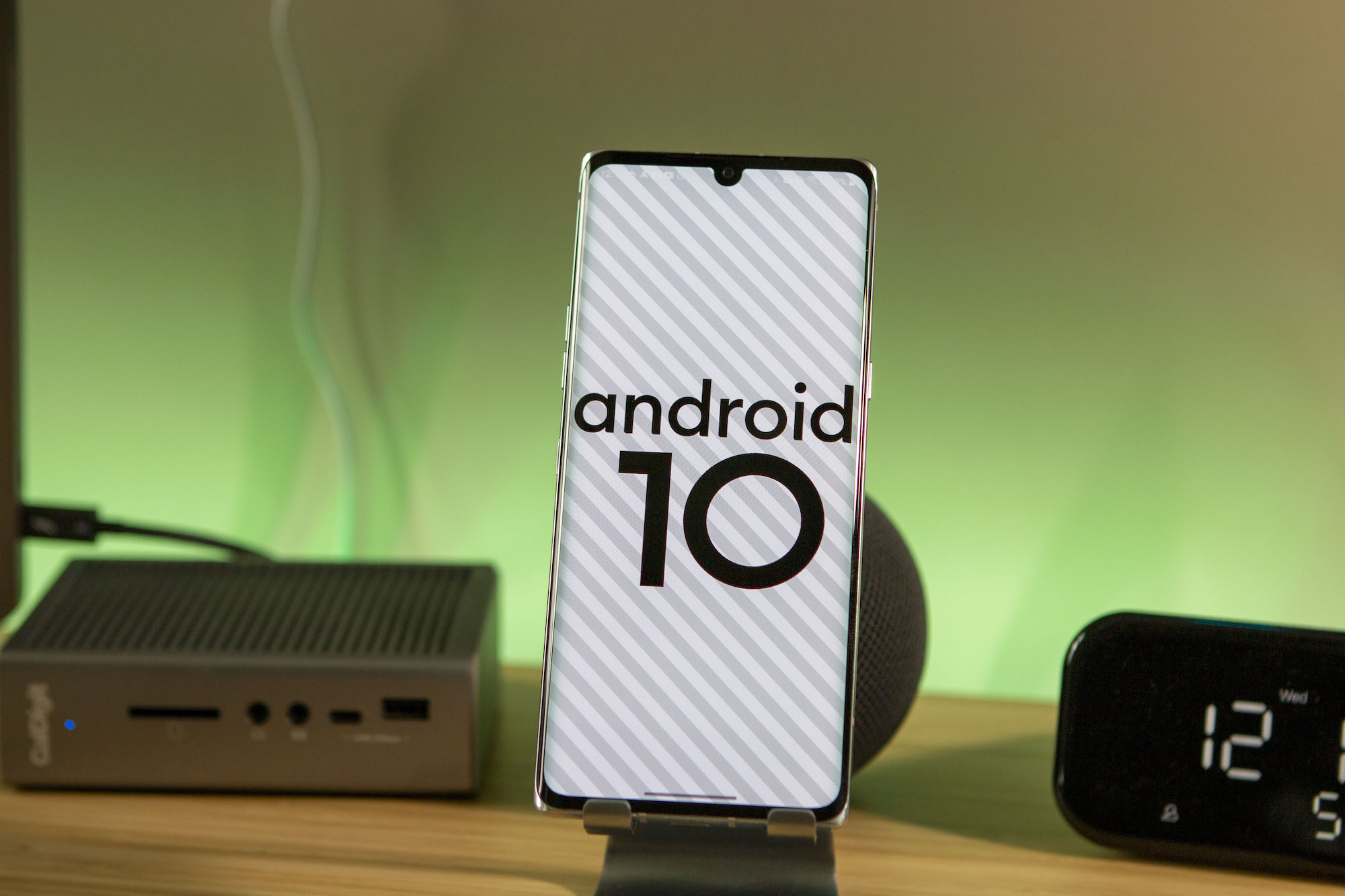Poco F3 Review - One of the best smartphones you can buy for $400 - Android
Poco F3 launched on March 22, 2021. Back in 2018 Poco took the smartphone world by storm with the original Pocophone F1. In my review time with this device, I believe that it is a true successor to the Pocophone F1. For folks who follow Xiaomi news closely, the Poco F3 is basically a Redmi [...]
Read More...
The post Poco F3 Review: One of the best smartphones you can buy for $400 appeared first on Android Headlines.

Poco F3 launched on March 22, 2021. Back in 2018 Poco took the smartphone world by storm with the original Pocophone F1. In my review time with this device, I believe that it is a true successor to the Pocophone F1.
For folks who follow Xiaomi news closely, the Poco F3 is basically a Redmi K40 by a different name. For the third iteration of the F series, Poco has gone back to the original formula of high-end specs at an unbelievably low price.
On paper, the Poco F3 spec sheet for around $400 is impressive. There is a 6.67-inch Super AMOLED with a 120Hz refresh rate, Snapdragon 870 with 6GB or 8GB of RAM, and 4,520mAh battery with 33W wired charging. That is a lot of extremely good hardware for $400. But do all these elements come together cohesively to justify the marketing tagline of “The Real Beast”? Let’s dive into the full review to find out.
Poco F3 Unboxing

The black cover gives way to a yellow box with a yellow Poco insert. Inside the insert, we have a TPU case, SIM tool, USB-C to headphone jack dongle, and a manual. Underneath is the Night Black Poco F3. One layer below is a USB-C cable and a 33w fast charging power brick. The phone has a factory-applied film screen protector. So in true Poco fashion, you get everything you need and nothing you don’t.
Poco F3 looks like a premium smartphone from a design perspective

My first impression upon unboxing the Poco F3 was that it looks eerily similar to the Redmi Note 10 Pro that I reviewed a month or so ago. And that is a good thing because I did love the design of that smartphone.
From a design perspective, I like a few things about the Poco F3. The first being the thickness of the device, which is only 7.8mm. Second, I like the glass, metal frame, glass construction which is what flagship smartphones tend to have. Both the front and rear glass are Corning Gorilla Glass 5. And third I like the design and layout of the rear camera module.

There is one interesting change compared to other recent Xiaomi devices in terms of the fingerprint scanner. The FPS is still integrated into the power button. But instead of it being recessed in the frame, we now have a tactile power button with the sensor built-in. That is pretty neat in my opinion.
Besides the FPS/power button, the right-hand side of the frame has a volume rocker. Moving to the top of the frame you can see two sets of three holes. The right-hand side has an IR blaster and microphone and the left-hand side holes are for the top stereo speaker. The left-hand side rail is devoid of anything. Finally, on the bottom of the frame, there is the SIM card slot, USB-C port, and the bottom speaker grille.
Backplate glass can be used as a mirror in an emergency

The rear back on the Night Black color review unit is a mirror polish glass so it is slippery as an eel and gets smudgy fingerprints practically the moment you pick it up. Thankfully there is a case in the box to help alleviate this problem.

The slippery surface is only on the Night Black color version. The other two colors – Arctic White and Deep Ocean Blue – have a matte finish on the back. So if you purchase those colors you shouldn’t have the problems I faced with my review unit. Here’s to hoping that my next review unit from Xiaomi is a different color than black. The reason being, it took me a very long time to take good pictures of this phone as part of the review.
The triple camera module looks quite stylish

I am a fan of the camera module design on this device. And yes, I am fully aware that it is just an iteration of the camera module you saw on the Redmi Note 10 Pro. However, I like the circular ring theme on this Poco F3 a bit better.
While you are looking at the 4 circles on the camera module remember that there are only three rear cameras. The lower right-hand side version is just for design symmetry.

On the front, you get the large 120Hz refresh rate display with uniform top and bottom bezels along with slightly thinner bezels on the side. The center hole punch isn’t too large and kind of fades into the background in most scenarios.
I like the attention Poco paid as far as distributing the 196-gram weight because the device feels quite light and balanced in hand. And the last hardware item that is vastly improved is the haptic feedback thanks to an improved linear motor.
The 6.67″ AMOLED display with a 120Hz refresh rate is bright and vivid

The 6.67″ display panel has a 1080×2400 pixel resolution (~395 ppi) along with a 20:9 aspect ratio. This large display lets Poco claim an impressive 85.9% screen-to-body ratio. In terms of refresh rate, we get 120Hz along with an even higher 360Hz touch sampling rate which is great for gaming and an overall smoother UI experience.
One other positive thing I noticed during the review is that the outdoor visibility on a bright sunny day is quite good thanks to the 1300 nits peak brightness. For daytime camera samples, I had no problems with outdoor visibility on a relatively hot sunny day in the Los Angeles area thanks to ‘Sunlight display 3.0’.
The display panel has support for HDR10+ for improved brightness and contrast. On top of that, a 5M:1 contrast ratio and 100% DCI-3 color gamut means brighter richer colors and deep blacks for an immersive viewing experience, especially on Netflix.
MEMC technology improves the fluidity of low frame rate content which helps when viewing action sports or stunts in movies. In addition, there are a couple of other features such as ‘Eye Care Display’ and ‘Seamless Pro 120Hz’ to improve the viewing experience in the evening hours. Of course, there are a few other items you can tweak within the Display Settings which MIUI is well known for.
POCO F3 is a real beast from a performance standpoint
Poco deserves kudos for using the second-best Snapdragon processor currently available on the market along with 8GB of LPDDR5 RAM for a device costing hundreds less than the competition. This formula was why the original Pocophone F1 sold like hotcakes. The Snapdragon 870 is essentially about a 10% improvement over last year’s flagship processor.
From a performance standpoint, these specs are close to last year’s big hit the Samsung Galaxy S20 FE. But as usual, I was not able to get Geekbench to run the benchmark tests. I tried to sideload AnTuTu but that did not seem to work either. I guess Poco/Xiaomi doesn’t want us reviewers running benchmark tests on our review units.
Despite the benchmark fiasco, based on my daily use I could not notice any difference between this phone and the S20 FE. And with a slightly better newer processor you should get longer use out of it before it inevitably slows down.
Playing intensive games on this device is a breeze at the highest settings thanks to the Adreno 650 GPU. There are plenty of YouTube videos showing the Poco F3 having no issues with graphics-intensive games such as Genshin Impact, PUBG, or Call of Duty even at their highest frame settings. And to help keep the phone cool while gaming there’s a new three-dimensional heat dissipation system called LiquidCool Technology 1.0 Plus.
The raw hardware specs on the Poco F3 are good enough that I don’t think MIUI’s Game Turbo is likely to make a huge difference while gaming. Its primary function is probably going to be about helping keep the notifications muted while you enjoy killing zombies.
Some other nice performance touches are the 36oHz touch sampling rate and the fast UFS 3.1 storage. Both of these are things you typically find in flagship devices and kind of unheard at the $400 price point.
At least from a performance standpoint, I think the Poco F3 is “The Real Beast”.
MIUI 12 with Poco Launcher has gotten better but still needs some work

The latest version of MIUI 12.0.1 finally has circular icons similar to what you can get on stock Android. Another positive aspect of the latest MIUI 12 is that an advertisement only pops up when you install an app from the Play Store. Other than that there aren’t any annoying ads within the UI experience.
There is however plenty of bloatware pre-installed on this device. Most of it is in two folders called ‘More apps’ and ‘Games’. Thankfully you can delete pretty much all of the apps or hide them away in the app drawer. There is one folder on the main page called ‘Tools’ which has meaningful apps like Recorder, Screen Recorder, Scanner, and Share Me.
Aside from the above items MIUI 12 is pretty similar to what has been reviewed earlier for Poco M3, Redmi Note 9T, and Redmi Note 10 Pro. In short, MIUI still has a lot of good things it has to offer.

There is a pretty decent amount of Google integration, which is a good thing. Swiping left from the home screen gets you the Google Discover Feed. The phone and messages apps are also stock Google. There is no alternate marketplace to get apps which is also a plus in my opinion.
One change I noticed this time is how you can set up the control center like standard Android or a clone of iOS. Regardless of which version you choose, I like how Xiaomi gives you a lot of options in terms of setting up your notifications and control center.
If you still don’t like what MIUI has to offer then you can always use the Theme store to set up the Poco F3 the way you like it. Overall, I think MIUI 12 with the Poco launcher is much more improved since the last Xiaomi device but I wish there were less bloatware and zero ads within the UI experience.
Poco F3 battery life is average

Battery life on the Poco F3 is average. Expect to get about 5 hours of screen-on-time especially when you are out of Wi-Fi range and using 5G.
Poco made a conscious design choice in terms of design versus battery capacity. Since the F3 is a thin device the battery capacity of 4520 while not being small isn’t big enough to allow charging every other day. However, on most days there shouldn’t be any issues in terms of using this phone for a full day.
In case you need a top-up during the day for some reason the 33W fast charging brick charges the phone to full capacity in 52 minutes. So a quick 15-20 minute charge should get you enough battery capacity to last till bedtime.
You can also just decide to turn on battery save mode and MIUI has a lot of battery saver options to help you with that. Some of the options enable granular level control for individual apps to keep battery drain at a minimum before you can find a charger.
Audio quality is excellent but no headphone jack this time around

Poco F3 has dual speakers with stereo sound including a speaker grille on the top rail as well. A separate speaker grille for the top speaker is something you don’t see even in top-tier flagship smartphones. Audio output from the dual speakers is excellent for the price point. Of course, the top speaker output is slightly less than the bottom-firing speaker.
While watching videos and playing games you get good sound quality overall even though it lacks a bit in terms of bass. However, the bass problem is difficult to overcome in a thin device. While indoors I mostly left the output at about 50% and it was plenty loud at that volume level.
Since we get a bit more upscale device in F3 and you know what that means – no headphone jack. But hey at least you get the USB-C headphone jack dongle in the box. And once the dongle is attached the audio quality output from the headphone jack is superb. I used my Audio Technica wired earbuds during my review period. And if you have any old wired Mi earbuds then you can custom tune the audio profile via MIUI sound equalizer options for a particular Mi earbud.
Audio quality via Bluetooth 5.1 is just as good as that from the 3.5mm jack dongle. And there is Hi-Res Audio certification for wireless and dongle versions. As an added bonus there is also Dolby Atmos support.
Let’s talk about call quality because after all, this is a device for making phone calls. Call quality is excellent in handset or speakerphone and this is true with BT earbuds too. In terms of audio performance, the Poco F3 punches way above its price point and is comparable to flagships out there.
So how good are the Poco F3 cameras?

There are three cameras on the Poco F3. The main camera at the top of the module is a 48MP ƒ/1.79 aperture, 1.6μm large pixel (4-in-1 pixel binning) sensor. Then there is a 5MP telemacro camera with ƒ/2.4 and at the bottom is the 8MP ƒ/2.2 ultra-wide camera with a 119° FOV.
Main camera performance is excellent
The main camera produces very good pictures regardless of the amount of light available. Night-time performance is actually quite competent considering the sensor and device price. Pictures in daylight, in direct sunlight, and in nighttime show good color accuracy and dynamic range. Detail gets a bit lost in some pictures but overall results are good for social media and an occasional print for an album.

As usual, the Camera app is fully featured and Pro mode has the ability to shoot pictures in RAW. Portrait mode works very well in indoor and outdoor light conditions. For Night mode you need to toggle over to the ‘More’ section of the app. Macro mode however is tucked away in the options within the main ‘Photo’ portion of the camera app.
There is plenty of processing power in the device so there is not much delay even during night mode shots. Check out the sample pictures in our Flickr gallery for pictures in various lighting conditions.
Poco F3 Camera Samples - Flickr Gallery
Selfie camera results are very good despite the obligatory beauty filter
Selfie camera in the front is 20MP with a ƒ/2.45 lens and the results are excellent for selfies including portraits. There is plenty of detail, good exposure, excellent edge detection, and good color accuracy. Of course, you do need to turn off beauty mode during setup to get authentic results. With ‘beauty mode’ turned off, results are good enough to pixel peep on a large screen monitor. One of the better selfie cameras in the $400 price range in my opinion.
Wide-angle camera results can be better and Video performance is good with one exception
Wide-angle camera results are good but the color accuracy is not great. Some of it can be attributed to the AMOLED screen calibration on the phone. But reviewing the photos on a color-tuned monitor reveals a definite blue shift in the color spectrum.
Video from the rear camera is capped at 4K 30FPS and for the front selfie camera, it is capped at 1080p 60FPS. There are separate video shooting modes for Macro, Sport modes, and Audio zoom which can come in handy in certain situations. There are additional shooting options in the More section such as Time-lapse, Dual Video, Short video, VLOG, Slow-motion, Long exposure and a few others.
The only thing I don’t like is that in video mode, you cannot get a wide-angle view if you start initially by choosing the main camera. That is not the case if you start the video in wide-angle mode. Lastly, the 2X telephoto is just digital zoom into the image from the main camera for both photo and video.
Overall though the camera performance is quite good in terms of photo and video. The only other phone in this price range with better quality is the Pixel 4a but it only has a single camera on the rear.
Connectivity is excellent with support for 11 5G bands

With the Snapdragon 870 onboard along with the X55 modem there is full 5G connectivity even in the USA. Poco claims that there is support for 11 5G bands worldwide. Alas, there is no mmWave support so this is mostly a T-Mobile phone in the USA from a 5G perspective.
The rest of the connectivity experience is identical to the Redmi Note 10 Pro including NFC support built-in for contactless payments or file sharing. Speaking of sharing you can also use Screen Cast, Nearby Share, and ShareMe from the control center.
Once you are done casting, you can use the IR blaster via the Mi Remote app to off the TV! While we are on the topic of casting, there is HDR 10-HEVC and Widevine L1 protocol support. This should result in some great video quality on Netflix.
During my review period in Southern California, there was a consistent 5G signal on T-Mobile. Data speeds were similar to what I get on my S20 FE or Galaxy S21. And just like other Xiaomi global devices, there is no VoLTE or Wi-Fi calling available in the USA. However, this is a non-issue for the markets where the Poco F3 is primarily going to sell in.
Rounding out connectivity options are WiFi 6 and Bluetooth 5.1 which did not present any issues during the review. As usual from a connectivity standpoint, the Poco F3 checks every single box and then some.
Arguably the Poco F3 is one of the best smartphones you can buy for $400

Poco F3 checks all the boxes in terms of hardware, design, display, connectivity, and audio performance. The main camera performance is excellent including nighttime results. The battery will also last you a full day despite 5G connectivity.
Sure the software has a few quirks and the color science on the wide-angle camera could be a bit better. Outside of these two minor things, there aren’t any egregiously glaring drawbacks to this device.
Poco has raised the bar on what a near-flagship device can look like for just $400. The Poco F3 is a true and worthy successor to the original Pocophone F1. And just like the original, I expect the sequel to be a runaway hit in terms of sales
The post Poco F3 Review: One of the best smartphones you can buy for $400 appeared first on Android Headlines.
08/04/2021 05:58 PM
Arkane's Deathloop delayed to September on PS5
08/04/2021 02:27 PM
eBay will let you scan trading cards to sell them faster
08/04/2021 01:35 PM
ViacomCBS May Debut Bundles With Pluto TV, Paramount+, Showtime + BET+
08/04/2021 03:51 PM
The iQOO 7 will be one of the cheapest Snapdragon 888 phones yet
08/04/2021 01:38 PM
Samsung uses Galaxy phones as fundus camera for cost-effective eye care
08/04/2021 03:15 PM
LG promises three years of updates for its “premium” smartphones
08/04/2021 10:19 AM
- Comics
- HEALTH
- Libraries & Demo
- Sports Games
- Racing
- Cards & Casino
- Media & Video
- Photography
- Transportation
- Arcade & Action
- Brain & Puzzle
- Social
- Communication
- Casual
- Personalization
- Tools
- Medical
- Weather
- Shopping
- Health & Fitness
- Productivity
- Books & Reference
- Finance
- Entertainment
- Business
- Sports
- Music & Audio
- News & Magazines
- Education
- Lifestyle
- Travel & Local







